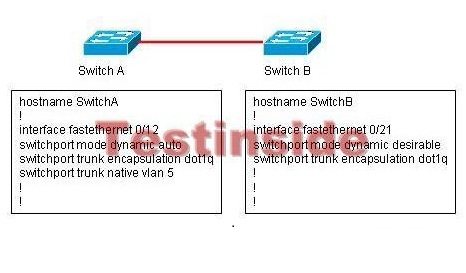Which three statements are true regarding the above diagram? (Choose three.)

A.
DTP packets are sent from Switch B.
B.
The native VLAN for Switch B is vlan 1.
C.
A trunk link will be formed.
D.
DTP is not running on Switch A.
E.
Only VLANs 1-1001 will travel across the trunk link.
Explanation:
You can manually configure trunk links on Catalyst switches for either ISL or 802.1Q mode. In addition, Cisco has implemented a proprietary, point-to-point protocol called Dynamic Trunking Protocol (DTP) that negotiates a common trunking mode between two switches. The negotiation covers the encapsulation (ISL or 802.1Q) as well as whether the link becomes a trunk at all.
You can configure the trunk encapsulation with the switchport trunk encapsulation command, as one of the following:
1. isl-VLANs are tagged by encapsulating each frame using the Cisco ISL protocol.
2. dot1q-VLANs are tagged in each frame using the IEEE 802.1Q standard protocol. The only exception is the native VLAN, which is sent normally and not tagged at all.
1. negotiate (the default)-The encapsulation is negotiated to select either ISL or IEEE 802.1Q, whichever is supported by both ends of the trunk. If both ends support both types, ISL is favored. (The Catalyst 2950 switch does not support ISL encapsulation.) In the switchport mode command, you can set the trunking mode to any of the following:
1. trunk-This setting places the port in permanent trunking mode. The corresponding switch port at the other end of the trunk should be similarly configured because negotiation is not allowed. You should also manually configure the encapsulation mode.
2. dynamic desirable (the default)-The port actively attempts to convert the link into trunking mode. If the far-end switch port is configured to trunk, dynamic desirable, or dynamic auto mode, trunking is successfully negotiated.
3. dynamic auto-The port converts the link into trunking mode. If the far-end switch port is configured to trunk or dynamic desirable, trunking is negotiated. Because of the passive negotiation behavior, the link never becomes a trunk if both ends of the link are left to the dynamic auto default.


